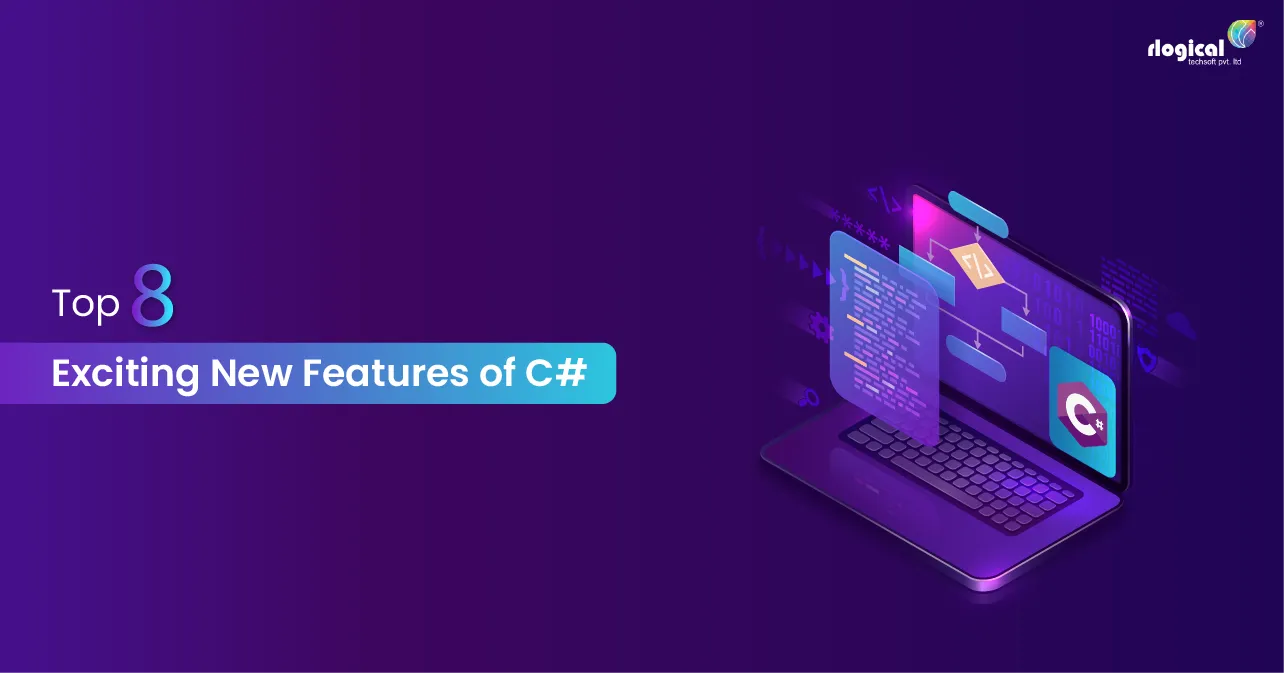
C# is a programming language that is preferred by coders for its simple keywords and uncomplicated development interface. The programming language is used for web development services. The language has been going through multiple updates in the past few years and there are some new features of C # that help developers and programmers. The release of the .NET 6.0 language in 2002 and the simultaneous release of C # 10 was a perfect opportunity to observe the features of the new language.
C# continues to be a relevant programming language even today. The language is still in demand and used by 1.5 million users daily around the world. An understanding of the C# language helps developers in the creation of better web apps and features. If you are a young web developer, this article on the new features of C# is for you. After reading this article, you can polish up your .NET Development services.
The new exciting 8 features of C# are as follows
1. The Global feature
The Global feature is a new feature of the C# language. The global feature reduces the amount of code a developer has to write to a huge extent. The feature simplifies the coding part of the programming framework, making it easy for the developer. The C# language uses a lot of statements that are repeated as program implementations. These user statements can be repetitive, especially in the ASP.NET development cycle.
Most of the repetitive using statements serve as noise for developers. Most of these language statements are rehashed in the process. With the global feature, the developer can specify the global keyword for the entire project. The process starts with creating a separate file for global keyword and then specifying the requirement in it. This allows all other files of the project to streamline according to the global keyword. This can be done through one file as other files do not have to include all the use cases of the global keyword. A coder refers to this as vertical wastage.
2. Structure improvements
Important enhancements to the structure of C# language also count under the new features. For example, you can declare the parameterless function () {[native code]} and then start the process of assigning instance field or property to the function. The function’s left hand operand counts as any structural type in language. It could be an unidentified reference type too. This has simplified the programming command and improved the interface for the programmer.
3. Record struct
The record struct and the read only record struct are two important functions of the programming language. The two declarations can be used to declare the value type records used in coding. This enables the coder to declare a record type as a reference for further coding.
4. Namespaces
The vertical wastage is minimized with the use of global keyword in C #. However, horizontal wastage is also minimized on the platform via a technique. The new feature of namespaces for files helps in reducing horizontal wastages. The namespace feature is introduced to reduce incidence of indent problems.
The namespaces increase the organization levels for C # language and makes the code look better. The namespace for files is a superficial feature that improves the overall presentation of the program. Using this feature the coder can declare the namespace at the file level. The use of namespaces for files labels the files and helps in categorization, resolving any persistent indent issues.
Also Read: Benefit and Drawbacks of ASP.NET Core Razor Pages
5. Strings with constant interpolation
Strings with constant interpolation is not a feature needed every time anything is coded. It is possible to leave an object straight inside the string without leaving its bounds. However, string interpolation is a worthwhile option of exploration. The coder can start with declaring two variables. When one of the variable is interpolated, it can be declared as constants because it does not change its value after interpolation.
6. Record types to seal Tostring
The coder can use a sealed modifier when the Tostring is overridden in a record type. When the ToString is sealed, the compiler of the program will not generate the ToString for any associated record types. A sealed ToString ensures that all the sourced record types for the method classify as a common source record type. This improves the organization of code and its usage in a certain program.
7. The improved line # pragma
The #line pragma has been introduced in the new C# version. Although it is not a feature mandatory for use by coders, it will impact the way programs are written. The #line pragma changes the way Domain-specific languages are operated. DSLs or domain-specific languages create more fine-grained inputs when they are used with the improved #line pragma. A DSL like Razor uses the #line pragma for better troubleshooting. The codes improve in accuracy and precision. The line allows debuggers to enhance their function when looking for the program’s Razor source. Although the #line pragma will not be used widely, it definitely puts a positive impact on the overall program execution.
8. Keywords
This is not the first time that C# has introduced self-implemented properties. Even before the present version, fields and keywords have existed in the framework. Once the program is coded and compiled, the compiler creates an anonymous, highly private field that has restricted access. The field is only accessed by a property associated with it. The property’s certain attributes help the keyword in unlocking the field. An init accessor built into the language framework is a new feature of the present version of C #.
The building of immutable objects is much more diverse and easy with an init accessor. The accessor helps the creator to alter the members while creating the object out of the programming language. The field itself is a keyword in the programming language of a new version. The coder does not need to introduce a new field for keywords in the current version. The init accessor can also function with this keyword.
Conclusion
Overall, the new features of the C# aim at simplifying and enhancing the functions of the language. The regular updates of the most used programming language make it a favorite among programmers. From its organization to its functions, the new features of the C# alter many properties of the programming language. Coders will be able to impart web development services in a better manner with the help of the new features. On the other hand, the new features will also support .NET Development services.
Rahul Panchal
Rahul Panchal is the Founder & Managing Director at Rlogical Techsoft Pvt. Ltd. He is a pioneer tech enthusiast who has assisted diverse enterprise solutions with a fresh perspective over the years. From integrating technologies like Full-Stack, .NET, Flutter & PHP, he has harnessed custom web or hybrid mobile app development projects. His creative outlook on the latest models of AI, ML, blockchain, and IoT, has made various businesses attain leading-edge success.
Related Blog
- Best PHP Frameworks For Your Web Development Project: PHP Tools Highlight in 2025
- How Much Does eCommerce Startup Cost - Guide to Calculate and Plan Budget
- How to Integrate AI and ML With .NET Applications to Skyrocket in Marketplace?
- Java or Dot Net: Which is Better for Web App Development?
- Why is the ASP.NET platform so popular for customized web apps?
Categories
- All
- AI Development Services
- Amazon Web Services (AWS)
- ASP.Net Development
- Azure Web App
- Big Data Analytic
- Customize
- Digital Marketing
- Drupal Development
- E-commerce web development
- Education Mobile App Development
- Enterprise Application
- Event Management App Development
- Fintech
- Fitness App Development
- Food Delievery
- Front-End Development
- Grocery App Development
- Healthcare App Development
- Hire Dedicated Developers
- Hotel Booking App
- IT Industry
- JavaScript Development
- Mobile App Development
- On Demand App Development
- On Demand Healthcare App Development
- PHP Development
- POS Software Development
- Real Estate Mobile App Development
- Retail Business App Development
- Salesforce
- Social Media Development
- Software Development
- Technology
- Transportation App Development
- UI/UX Design
- Web Design
- Web Development
- Web Services
- Web/Data Scraping Services
- WordPress




 Rahul Panchal in ASP.Net Development
Rahul Panchal in ASP.Net Development 





